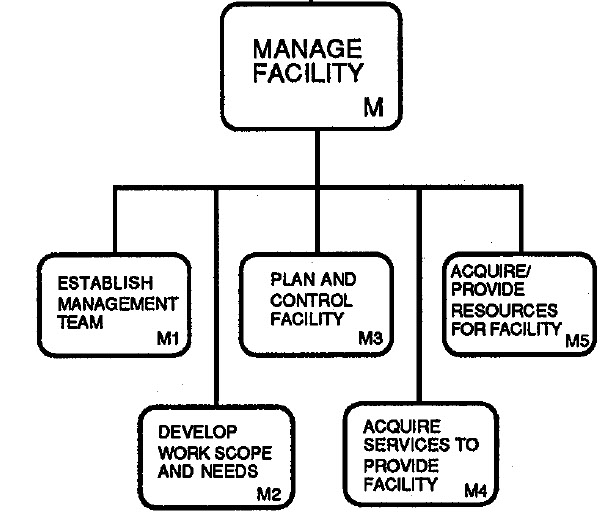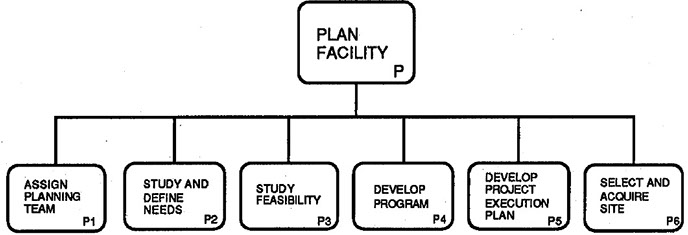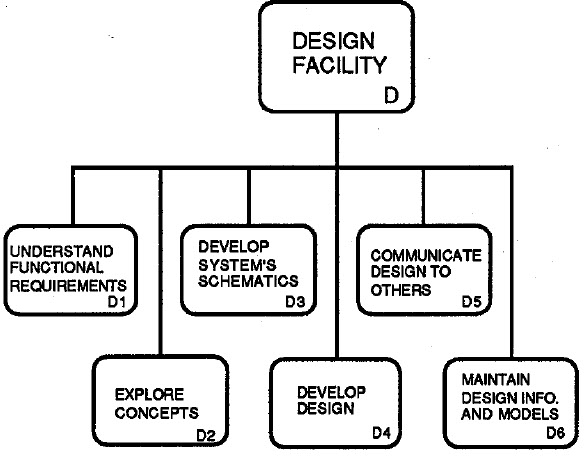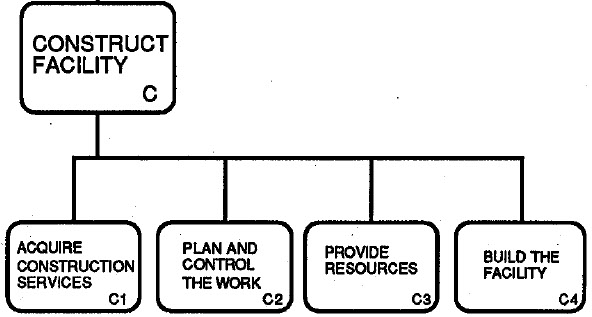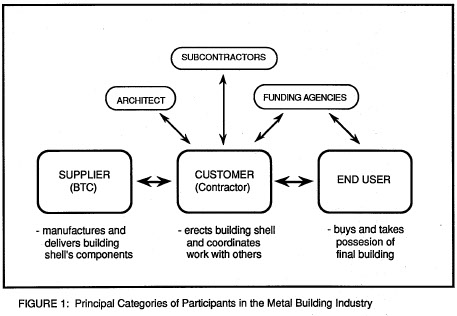Gonzales Construction handles all phases of the Integrated Building Process Model for nearly all of its Metal Building projects. Unlike many of the companies that only sell you their building, Gonzales Construction can assist you with every single step of the Metal Building Construction process. The following description is a narrative of the different steps involved in constructing a Metal Building.
Metal Building Management Activities
Management and overall coordination of a project, from a life cycle viewpoint, begins and ends with the Metal Building Contractor. The Metal Building Contractor manages the architectural aspects (taking the function and turning it into form) and with the overall provision of the facility (i.e. dealing with the codes applicable to a particular geographic area). These activities are the Metal Building Company's internal management of the process and the production planning required to fabricate the Metal Building Components.
When the Metal Building Manufacturer receives an order, they first verify the description of the building, estimate the lead time it will take to deliver the components, and quote a price to the contractor based on the code requirements used. Once these activities are performed it becomes a matter of satisfying the design requirements set by the Metal Building Contractor's order and their own design process. The outputs received from design are fabrication drawings and a bill of materials. The bill of materials defines all the quantities used for a job, as well as the sub assemblies that make up the various assemblies and components. Once the bill of materials is completed, the company uses interactive graphics / drafting to produce a set of erection drawings which show the layout of a building a piece at a time; this is done by coding numbers on parts for layout. Once the Metal Building Erection drawings are completed and checked, the manufacturing process (and the management of that process) begins for all the Metal Building parts. After fabricating, welding, finishing, and painting, the parts are packaged and shipped to their assigned destinations.
The Metal Building Contractor assumes responsibility for the manufactured building items once they leave the plant. From this point on, it becomes a question of how quickly the Metal Building Contractor or his subcontractors can erect the building.
Metal Buildings Planning Activities
The “planning” of the Metal Building can be defined as the development of the Metal Building idea into a facility program, a project execution plan, and site information. These plans drive the remaining functions of Design Facility and Construct Facility by supplying them with some critical information. This phase is divided into the following six sub functions:
1. Assign Planning Team
2. Study and Define Needs
3. Study Feasibility
4. Develop Program
5. Develop Project Execution Plan
6. Select and Acquire Site.
Plan Facility activities clarify the Metal Buildings project requirements and the owner's constraints as well as provides the owner with the chance to influence the project through his decisions at this stage. It is typically performed by the owner, but may be performed by an external consultant depending on the nature of the facility and the owner's experience.
Planning of Metal Buildings
Much of the planning of a Metal Building is performed by the end user and the Metal Building Contractor prior to the Metal Building Manufacturer being brought into the picture. In a general sense, planning a Metal Building is similar to planning almost any other type of facility. Once the facility needs have been determined, the end user may turn to a Metal Building Contractor to assist him in the evaluation of a Metal Building as an option. The Metal Building Contractor assists the user in determining what physical characteristics of the structure (bay spacing, overall dimensions, exterior coverings, etc.) are needed or wanted. In some instances, the Metal Building Contractor may hire an architect to help with this. As a final step, an order is made to the Metal Building Manufacturer for the selected structure and shell.
Metal Buildings Design Activities
Design Facility activities comprise all the functions required to define and communicate the owner's needs to the Metal Building Contractor. It is broken into the following six sub functions:
1. Understand Functional Requirements
2. Explore Concepts
3. Develop System's Schematics
4. Develop Design
5. Communicate Design to Others
6. Maintain Design Information and Models
Metal Building Design is the method by which the needs, wishes, wants, and desires of the owner are defined, quantified, qualified, and communicated to other parties. Design must also take into account the demands society places on it. The activities of this process translate the facility program and execution plan into bid and construction documents and operations documents which allow the facility to meet the owner's and society's needs.
The overall approach in the Metal Buildings industry is shifting from supplying a stocked product to one of custom design and fabrication. Previously, a customer would review a catalog of available structures when a Metal Building was needed. The catalog represented the only options available to the customer. His needs had to be tailored to fit the available Metal Buildings. However, the trend today is toward more custom design and construction. Catalogs still are used but they provide only a base from which the design is begun. There are many options which can be added or deleted from any particular design. It is now the Metal Buildings which must be tailored to fit the needs. Coordination between the various designers on a project (i.e., the Metal Building Manufacturer, HVAC designer, electrical designer, etc.) is usually the responsibility of the Metal Building Contractor.
Review of known information by the design engineers. Certain design parameters are readily available in-house such as available materials with their thicknesses, sizes, shapes, etc. Much of the information comes from the Order Form filled out by the customer. The customer will often supply drawings or sketches of the desired building.
Design of primary frame elements such as columns and beams. This step is the most time consuming; using 50 - 60% of the designer's time as well as 50 - 65% of the detailer's time. The design of these members is almost completely computer generated. First the nominal information is gathered and assembled from the previous step. Next, it is entered into the computer (a mainframe in this case) where the design is developed via an interactive, iterative program called TALON. This program designs within the constraints set by the designer, customer, and the applicable building codes. Special cases, such as craneway design, may be done in a PC environment.
Design of secondary frame elements such as purlins and girts. These are often taken straight off of design charts and are not usually computer aided. Wind and other loading checks, however, may done using personal computers, simply because done manually, they would be very time-consuming.
Detailing of the design. The detailers get the design information from the designers to help in the production of fabrication drawings. These are most often done on the computer. Detailers will usually make the changes necessary for doors and windows or other customer changes. Fabrication drawings, the principal output of the design process, aren't necessarily to scale; they're only meant to be descriptive of the structural members and system. There is much less information on them than on typical shop drawings.
Metal Buildings Construction Activities
The Construct Facility phase is comprised of the following activities:
1. Acquire Construction Services
2. Plan and Control the Work
3. Provide Resources
4. Build the Metal Building
All construction is performed by the Metal Building Contractors, this is the standard in the industry. Recently, the majority of the construction-type work performed by Metal Building Contractors has been that of custom work, paralleling the trend in the industry's design process. In fact, approximately 80% of their orders are now custom building work showing that the industry is branching more towards the design-build method of construction. These warranties cover such performance factors as corrosion resistance of roof panels, paint systems, and water tightness.
Metal Buildings Construction
The Metal Building Contractor will receive the structure and shell from the manufacturer with a set of erection drawings. These drawings show the relationships between the various elements of the structure and the part numbers. Typically, each component has a numbering or coding system on it which identifies the specific piece and its location in the structure. The Metal Building Contractor, or one of his subcontractors, then erects the shell according to the erection drawings. This usually occurs quickly and is one of the primary advantages of these systems over more traditional methods and systems of construction.
